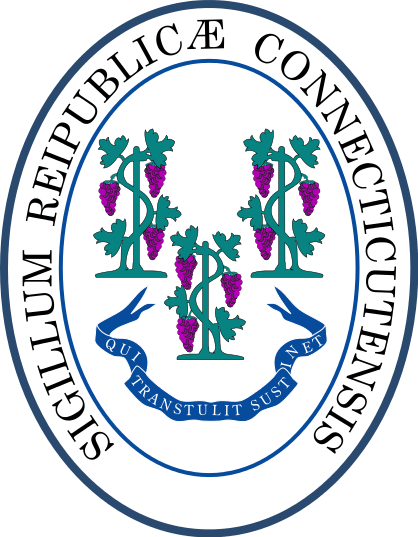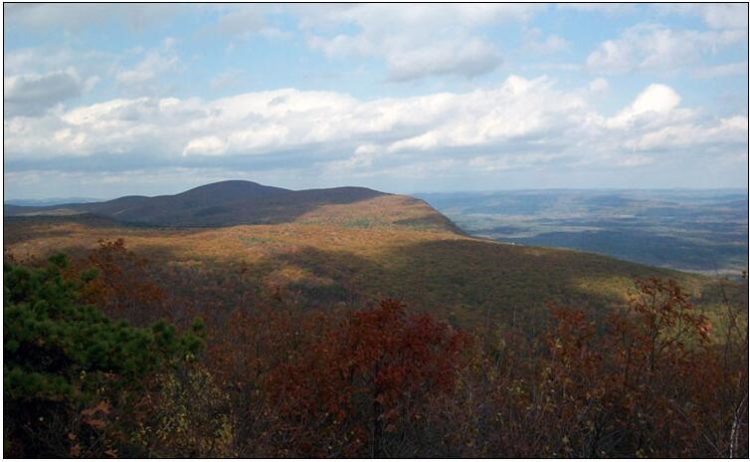Connecticut is a state in the northeastern United States and part of the region of New England. Connecticut was one of thirteen colonies that rebelled against the Kingdom of Great Britain during the American War of Independence.
The name arose from the French corruption of the Mohegan word quinnehtukqut , which means something like long river (the tide).
The state bears the official nickname “The Constitution State”, which was adopted by law in 1959, and is also known as the “Provision State”. This name comes from the fact that during the American Revolutionary War the Continental Army was supplied with provisions from Connecticut; the state hardly saw any fighting in its own country.
| Area | 14,357 km² |
| Residents | 3,576,452 |
| Residents per km² | 249.1 |
| Capital | Hartford |
| Postal Code | CT |
| ISO-3166-2 code | US CT |
| FIPS code | 09 |
Geography
Connecticut, the third smallest state in the United States, is located in the northeastern United States on the Atlantic Ocean. The state extends over 177 km between 40 ° 58’N and 42 ° 3’N and 113 km between 71 ° 47’W and 73 ° 44’W. Connecticut is bordered by Massachusetts to the north, Rhode Island to the east, Long Island Sound to the south, and New York to the west.
The state is traversed by the largest river in New England : the Connecticut River. 1,809 km² (12.6 percent) of the area of the country is covered by water and 56 to 63 percent of the land area is forested, otherwise hills, lakes and plains (including the 16 km wide coastal plain) characterize the country. Part of the Appalachian Mountains forms the highest peaks ( Mount Frissell 725 m) in the state.
History
The Dutch Adriaen Block was the first European to come to Connecticut in 1614. At that time there were 16 Algonquin Indian tribes with 6,000–7,000 people.
The first Englishmen came to the country from Massachusetts in 1633. Two years later the settlements of Windsor and Wethersfield were established. Thomas Hooker founded Hartford in 1636. The three settlements merged to form Connecticut in 1639. In the same year the New Haven colony was established. In 1662 Connecticut was granted autonomy approved by King Charles II and its own constitution. In 1665 Connecticut and New Haven merged.
In July 1776 Connecticut declared independence from Great Britain as one of the Thirteen Colonies and became the fifth state of the United States on January 9, 1788. The slavery was abolished 1848th
Economy
Connecticut is one of the wealthiest states with one of the highest standards of living and education. The main crops grown in Connecticut are cereals, potatoes, tobacco, corn and oats. Ordinary animal husbandry is practiced in the state.
Connecticut is a very industrial state, manufacturing aircraft engines, machines, metal goods, textiles, nuclear submarines, and various chemical products, among other things. It is said that the Frisbee was also invented there.
The real gross domestic product per capita (per capita real GDP) was USD 73,643 in 2016 (national average of the 50 US states: 57,118; national ranking: 4).
The unemployment rate was 4.1% in October 2018 (national average: 3.7%).
New England
New England (English New England ) refers to an area in the northeast of the USA, which was the origin of the English colonization of North America, along with Virginia. The New England region includes the present-day states of Connecticut, New Hampshire, Maine, Massachusetts, Rhode Island and Vermont. In addition to Virginia, New England is the part of the country with the most ancient European settlement history. The first British colony in New England to survive was the Plymouth Colony, a foundation of the famous “Pilgrim Fathers”, who arrived here on board the Mayflower in 1680. Other early foundations were the Massachusetts Bay Colony (1629), the Connecticut Colony (1636), and the New Haven Colony (1637).
The Central Atlantic states join to the west.
History
The name New England goes back to the mercenary and adventurer John Smith, who traveled and explored this area extensively around 1614. In 1616 he published a detailed description of this region in his book A Description of New England. He mentioned in particular the abundance of fish and wood in the area, which made later English settlers aware of this region.
Colonization
The colonization of New England began in the 17th century with settlements near the coast. In 1620 the Pilgrim Fathers founded the settlement of Plymouth (Plymouth Colony). After 1629, as part of the Great Migration, tens of thousands of Puritans emigrated from England to the Massachusetts Bay Colony, founded that year, and established settlements such as Boston, Salem and Roxbury.
Further development of the region
During the 18th century, Boston developed into one of the most important ports in America. The unrest in connection with the so-called Boston Tea Party on December 16, 1773 is considered to be the trigger for the Revolutionary War that led to the Declaration of Independence in 1776. Hence, Boston and New England are considered to be the birthplace of the United States.
The bourgeois, small-town character of this region caused its residents to repeatedly stand in contrast to the southern states, which are characterized by plantation economy. New England was a major abolitionist stronghold in the 1860s. Yankee, originally a nickname for New Englanders, is still a dirty word in the southern states. Today, New England is considered liberal by US standards. In elections there, the Democratic Party usually wins, until about the Second World War, the then more liberal Republican Party was usually supported. The well-known universities of Yale, Harvard and MIT are located here.
Maine, the largest and northernmost of the New England states, is known for the beauty and unspoiled nature. In autumn there is a unique spectacle in the woods, the Indian Summer, when the leaves of the trees turn orange-red.
States
The states of New England include:
- the northernmost of the New England states: fishing villages on the coast, wooded and sparsely populated inland, overwhelming views in Acadia National Park
- New Hampshire – rugged mountains, idyllic lakes and a short ocean coast
Vermont – unique rural charm, the autumnal color of the leaves is considered the most beautiful in the USA, the center of maple syrup production - Massachusetts – the starting point of the American Revolution, with the culturally diverse metropolis of Boston, several elite educational institutions and the Cape Cod peninsula jutting out into the ocean
- Rhode Island – the smallest state in the USA, beautiful ocean coast and islands
- Connecticut – the “front yard” of New York, numerous universities and colleges in the “Knowledge Corridor”; Mystic Seaport open air museum, large saltwater aquarium, vibrant downtown New Haven
Also known as Constitution State / Nutmeg State, Connecticut is short for CT with a population of 3,405,565. The capital city of Connecticut is Hartford and the biggest city is Bridgeport.

